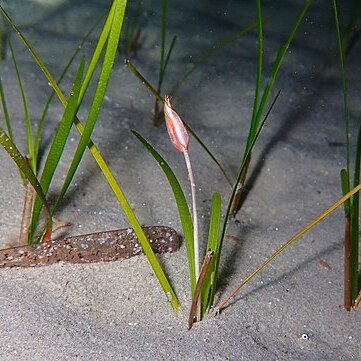Herbs, perennial, rhizomatous, caulescent; turions absent. Leaves submersed, alternate or nearly opposite, sessile; sheath persisting longer than blade, leaving circular scar when shed, not ligulate, auriculate, lobes not scarious; blade linear; intravaginal squamules scales, more than 2. Inflorescences axillary or terminal, solitary or cymes, without spathe, sessile or pedunculate; peduncle, when present, not elongating following fertilization, not spiraling. Flowers uniasexual, staminate and pistillate on separate plants; subtending bracts absent; perianth absent. Staminate flowers: stamens 2, in 1 series; anthers adaxially connate, dehiscing vertically; pollen linear. Pistillate flowers: pistils 2, distinct, not stipitate; ovules pendulous, orthotropous. Fruits achenelike or drupaceous. Seeds 1; embryo straight.
Marine plants, perennial, dioecious, glabrous; rhizome creeping; vessel elements absent. Leaves distichous or spiral; leaf-sheath amplexicaul, with 2 apical auricles, ligulate; blade linear with several parallel nerves, in between which tannin dots and dashes are visible. Flowers terminal and solitary on a short branch, or in cymose inflorescences, sessile or stalked, small, water-pollinated; tepals absent. Staminate flowers consisting of 2 anthers, these 4-locular, partially connate, dehiscing by extrorse slits; pollen thread-like, without exine. Pistillate flowers of 2 free ovaries; ovule 1, pendulous. Fruit an indehiscent nutlet; seed 1; endosperm absent
Plants submerged in salt water. Rhizomes creeping, usually slender. Stems shortened. Leaves sessile, alternate, subopposite, or crowded at nodes, linear, with conspicuous midvein, sheathing at base. Plants dioecious. Flowers minute, unisexual, solitary or in cymes. Male flowers pedunculate; perianth of 3 small scales or absent; stamens 1-3; anthers connate, sessile, longitudinally dehiscent; pollen grains threadlike. Female flowers sessile; perianth absent or cupular or of 3 segments; carpels 2, free; style simple or divided into 2(-4) filiform stigmas; ovule 1, pendulous. Fruitlet achene-or nutlike. Seeds without endosperm.

